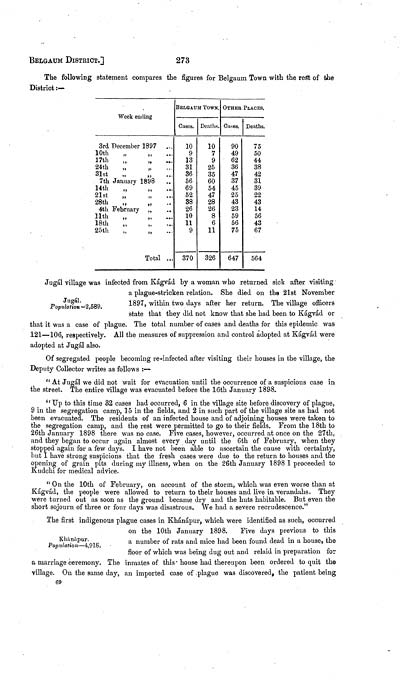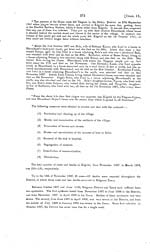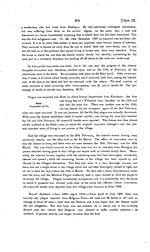Medicine - Disease > Bombay plague: being a history of the progress of plague in the Bombay presidency from September 1896 to June 1899
(349) Page 273
Download files
Individual page:
Thumbnail gallery: Grid view | List view

BELGAUM DISTRICT.] 273
The following statement compares the figures for Belgaum Town with the rest of the
District :-
Week ending
BELGAUM TOWN.
OTHER PLACES.
Cases.
Deaths.
Oases.
Deaths.
3rd December
1897
...
10
10
90
75
10th "
"
...
9
7
49
50
17th "
"
...
13
9
62
44
24th "
"
...
31
25
36
38
31st "
"
...
36
35
47
42
7th January
1898
...
56
60
37
31
14th "
"
...
69
54
45
39
21st "
"
...
52
47
25
22
28th "
"
...
38
28
43
43
4th February
"
...
26
26
23
14
11th "
"
10
8
59
56
18th "
"
...
11
6
56
43
25th "
"
...
9
11
75
67
Total
...
370
326
647
564
Jngl.
Population -2,589.
Jugl village was infected from Kgvd by a woman who returned sick after visiting
a plague-stricken relation. She died on the 21st November
1897, within two days after her return. The village officers
state that they did not know that she had been to Kgvd or
that it was a case of plague. The total number of cases and deaths for this epidemic was
121-106, respectively. All the measures of suppression and control adopted at Kgvd were
adopted at Jugl also.
Of segregated people becoming re-infected after visiting their houses in the village, the
Deputy Collector writes as follows :-
" At Jugl we did not wait for evacuation until the occurrence of a suspicious case in
the street. The entire village was evacuated before the 16th January 1898.
"Up to this time 32 cases had occurred, 6 in the village site before discovery of plague,
9 in the segregation camp, 15 in the fields, and 2 in such part of the village site as had not
been evacuated. The residents of an infected house and of adjoining houses were taken to
the segregation camp, and the rest were permitted to go to their fields. From the 18th to
26th January 1898 there was no case. Five cases, however, occurred at once on the 27th,
and they began to occur again almost every day until the 6th of February, when they
stopped again for a few days. I have not been able to ascertain the cause with certainty,
but I have strong suspicions that the fresh cases were due to the return to houses and the
opening of grain pits during my illness, when on the 26th January 1898 I proceeded to
Kudchi for medical advice.
" On the 10th of February, on account of the storm, which was even worse than at
Kgvd, the people were allowed to return to their houses and live in verandahs. They
were turned out as soon as the ground became dry and the huts habitable. But even the
short sojourn of three or four days was disastrous. We had a severe recrudescence."
Khnpur.
Population-4,918.
The first indigenous plague cases in Khnpur, which were identified as such, occurred
on the 10th January 1898. Five days previous to this
a number of rats and mice had been found dead in a house, the
floor of which was being dug out and relaid in preparation for
a marriage ceremony. The inmates of this house had thereupon been ordered to quit the
village. On the same day, an imported case of .plague was discovered, the patient being
69
The following statement compares the figures for Belgaum Town with the rest of the
District :-
Week ending
BELGAUM TOWN.
OTHER PLACES.
Cases.
Deaths.
Oases.
Deaths.
3rd December
1897
...
10
10
90
75
10th "
"
...
9
7
49
50
17th "
"
...
13
9
62
44
24th "
"
...
31
25
36
38
31st "
"
...
36
35
47
42
7th January
1898
...
56
60
37
31
14th "
"
...
69
54
45
39
21st "
"
...
52
47
25
22
28th "
"
...
38
28
43
43
4th February
"
...
26
26
23
14
11th "
"
10
8
59
56
18th "
"
...
11
6
56
43
25th "
"
...
9
11
75
67
Total
...
370
326
647
564
Jngl.
Population -2,589.
Jugl village was infected from Kgvd by a woman who returned sick after visiting
a plague-stricken relation. She died on the 21st November
1897, within two days after her return. The village officers
state that they did not know that she had been to Kgvd or
that it was a case of plague. The total number of cases and deaths for this epidemic was
121-106, respectively. All the measures of suppression and control adopted at Kgvd were
adopted at Jugl also.
Of segregated people becoming re-infected after visiting their houses in the village, the
Deputy Collector writes as follows :-
" At Jugl we did not wait for evacuation until the occurrence of a suspicious case in
the street. The entire village was evacuated before the 16th January 1898.
"Up to this time 32 cases had occurred, 6 in the village site before discovery of plague,
9 in the segregation camp, 15 in the fields, and 2 in such part of the village site as had not
been evacuated. The residents of an infected house and of adjoining houses were taken to
the segregation camp, and the rest were permitted to go to their fields. From the 18th to
26th January 1898 there was no case. Five cases, however, occurred at once on the 27th,
and they began to occur again almost every day until the 6th of February, when they
stopped again for a few days. I have not been able to ascertain the cause with certainty,
but I have strong suspicions that the fresh cases were due to the return to houses and the
opening of grain pits during my illness, when on the 26th January 1898 I proceeded to
Kudchi for medical advice.
" On the 10th of February, on account of the storm, which was even worse than at
Kgvd, the people were allowed to return to their houses and live in verandahs. They
were turned out as soon as the ground became dry and the huts habitable. But even the
short sojourn of three or four days was disastrous. We had a severe recrudescence."
Khnpur.
Population-4,918.
The first indigenous plague cases in Khnpur, which were identified as such, occurred
on the 10th January 1898. Five days previous to this
a number of rats and mice had been found dead in a house, the
floor of which was being dug out and relaid in preparation for
a marriage ceremony. The inmates of this house had thereupon been ordered to quit the
village. On the same day, an imported case of .plague was discovered, the patient being
69
Set display mode to: Large image | Zoom image | Transcription
Images and transcriptions on this page, including medium image downloads, may be used under the Creative Commons Attribution 4.0 International Licence unless otherwise stated. ![]()
| India Papers > Medicine - Disease > Bombay plague: being a history of the progress of plague in the Bombay presidency from September 1896 to June 1899 > (349) Page 273 |
|---|
| Permanent URL | https://digital.nls.uk/74586666 |
|---|




